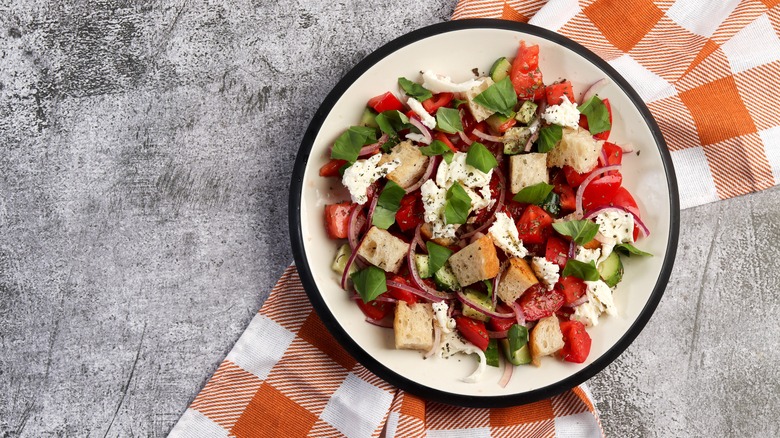Ancient Rome's Version Of Bread Salad Was Basically A Big Wet Sandwich
Ancient Roman cookbooks contain some of the earliest recipes for sweet and savory dishes that have stood the test of time like Italian sausage, cheesecake, pesto, and even deviled eggs. Other recipes have been left to the annals of history. The famous Roman gastronome and writer Marcus Gavius Apicius, who lived during the first century C.E., dreamt up several dishes that fit into the latter category, including something he called "bread salad."
A far cry from panzanella, that beloved summer salad that makes use of stale bread and fresh tomatoes, Apicius whipped up what can only be described as a big wet sandwich. He started by flanking sliced chicken between two layers of bread, followed by a layer of organ meat from a lamb's thymus gland and pancreas, also known as sweetbreads. The layers kept coming with shredded cheese, pine nuts or almonds, minced onions, cucumber, and a final layer of bread to cap it all off.
The dish was doused in a generous amount of sweet, flavorful dressing made of celery seed, pennyroyal, mint, ginger, coriander, and raisins, bound together by honey, vinegar, olive oil, and white wine. With its creamy sweetbreads, ostensibly tender chicken, soft bread, and crunchy vegetables, the dish certainly gets points for textural range.
A vegetarian version trades sweetbreads for snow
In "De Re Coquinaria," the book that features his bread salad, Apicius also includes a vegetarian-friendly version of the dish that inches closer to the kind we eat today, save for a couple of key ingredients that have fallen out of popular rotation. Dubbed "Sala Cattabia," the simple salad called for bread, cheese, garlic, honey, black pepper, olive oil, posca (a kind of drinking vinegar), fresh herbs like mint and cilantro, and snow, which was preserved throughout the year and commonly used to cool down food and wine.
Before building the salad, the dry bread was soaked in posca until soft, then drained of its excess liquid. It was then plated on a layer of snow and topped with the additional ingredients, which were pounded into a creamy paste in a mortar and pestle. With only three layers, it's not quite as sandwich-like as its meaty counterpart but it's just as unique.
From ancient bread salad to the modern panzanella
These days, if we saw bread salad on a menu we'd assume it meant panzanella, the aforementioned dish with roots in 14th-century Tuscany. Like Apicius' vegetarian version, panzanella salad is made with rustic stale bread like sourdough that is stripped of its crust and soaked in liquid. In many other recipes, they skip the pre-soak stage and let the vinegar-based dressing do the work. Together with fresh tomatoes, onion, garlic, basil, and the optional smattering of mozzarella and cucumbers, the salad chills in the fridge until the bread has soaked up all those good flavors.
However, if the idea of eating soggy bread turns you off, you can always toss a panzanella salad in the blender with some extra olive oil — it's a bona fide hack for homemade gazpacho. We're not sure the same method could be applied to Apicius' meaty bread salad, but no one's stopping you from trying.


